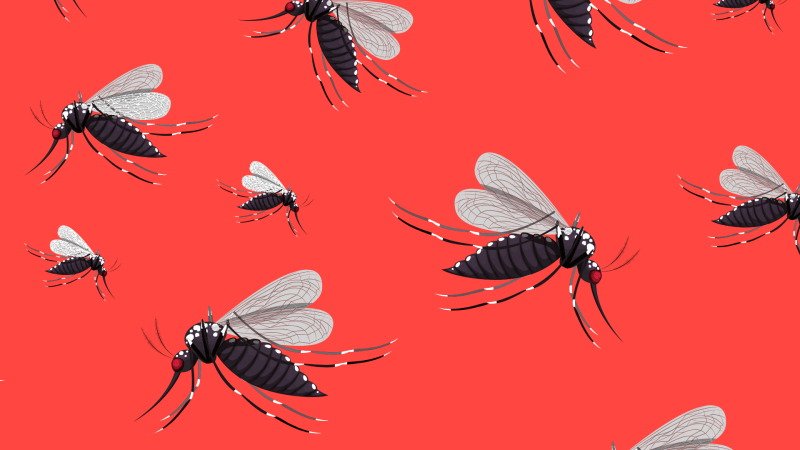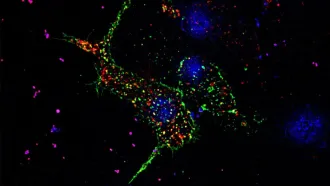
Mosquitoes are not only known for their pesky bites, but also as vectors for transmitting about 17% of all infectious diseases—dengue, malaria, chikungunya and the likes. The female mosquitoes devour the blood meal to meet their protein and iron needs to lay their eggs, eventually transmitting several diseases. One such severe problem caused by mosquitoes is lymphatic filariasis, also known as elephantiasis. In a recent study, researchers from the Indian Institute of Chemical Technology, Hyderabad, University of Nevada, USA, and University of Georgia, Athens, USA, have provided insights into potential of developing a novel insecticide to control mosquitoes and filarial parasites.
Lymphatic filariasis, considered as one of the neglected tropical diseases worldwide, is a parasitic disease affecting the lymph nodes. It causes swelling and thickening of the skin and leads to permanent disability. Though filariasis is caused by three species of nematode worms (filariae), Wuchereria bancrofti (Wb), transmitted by mosquito species belonging to the genera Culex, Anopheles, Aedes and Mansonia, affect humans the most.
According to the World Health Organization, 120 million people across 55 countries are infected by this disease. In India, Culex quinquefasciatus is the primary vector of Wb, approximately constituting 45% of the world’s lymphatic filariasis burden. Improper drug administration, insecticide resistance in mosquitoes and drug resistance in the parasite, are often blamed for the spread of the disease.
In the current study, the researchers have found a link between a biological mechanism involved in the glucose uptake in cells, insulin signaling, and the filarial worm development in the mosquito Culex quinquefasciatus. The study, published in the journal PLOS Neglected Tropical Diseases, has provided clues on how insulin signaling can be targeted for development of a mosquito-specific, safer, and effective insecticide against mosquitoes and filarial parasites.
Filarial worms multiply inside vertebrates and undergo a developmental stage within mosquitoes. The ability of mosquitoes to acquire and mobilize nutrients plays a crucial role in the development and transmission of these worms. Filarial parasites are taken up by the mosquito when the female mosquito feeds on an infected person. Filarial development within mosquitoes takes 10-12 days to complete, during this time the parasite moves from mosquito’s midgut (stomach) to flight muscles (where it grows to infective stage), and finally into head via hemolymph (mosquito’s blood). When mosquito takes another blood meal from an uninfected person, the filarial parasites comes out of mosquito’s head and make their way into the bloodstream through skin.
In mosquitoes, like most organisms, insulin receptors—proteins found on the surface of the cells, help them in the absorption of glucose through the conserved insulin signaling pathway. Like in humans, insulin-like peptides (mosquitoes’ insulin) binds to the receptor and help uptake of the nutrients by the cell. These nutrients regulate reproduction by providing the energy for the development and laying of eggs.
In the study, the researchers silenced the gene responsible for producing the insulin receptor protein in Culex quinquefasciatus mosquitoes. They then infected these mosquitoes with the filarial parasite, Wuchereria bancrofti, for understanding the role of insulin signalling in filarial worm development. They observed how the absence of the mosquito insulin signalling mechanism affected the development of the filarial worms and found that silencing insulin receptor of mosquitoes resulted in complete lack of developmental stages of the worm in mosquito body parts.
“This could be due to either the death of filarial worms at early larval stages before reaching thoracic muscles or failure to mature due to nutrient limitation,” says Dr Monika Gulia-Nuss, Assistant Professor in Biochemistry, University of Nevada, USA, and the lead author of the study.
Insulin receptors silencing also interfered with blood digestion in the gut of the mosquitoes, resulting in further decrease in nutrients from the blood. These mosquitoes also had reduced levels of ecdysteroid—an insect hormone involved in moulting and reproduction.
The researchers also observed a drop in the egg-laying capacity of the infected mosquitoes. While the uninfected mosquitoes deposited 92 eggs per female within 96 hours after ingesting human blood meal, the infected mosquitoes laid only 58 eggs (37% fewer). The insulin receptor silenced mosquitoes produced no egg production at all. This observation shows that silencing the insulin receptor and the prevalence of Wb infection decreases the egg-laying capacity of the mosquitoes.
In tropical countries like India, where the mosquito menace is a major public health issue, this research could help us understand some of the underlying biological mechanisms at play in the transmission of these diseases.
“This is a proof-of-concept study that strongly suggests a link between mosquito insulin signalling and pathogen development within the mosquito vector. In the future, we plan to study the insulin signalling mechanism in both filarial and malarial parasite development. We are also evaluating insulin receptor antagonists—small molecules that bind to the receptor—which could be used as a novel insecticide to block the transmission of parasites”, says Dr Gulia-Nuss, describing the future direction of this study.






